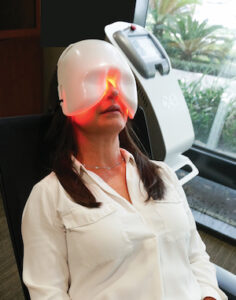What is Dry Eye and Meibomian Gland Deficiency?
The surface of our eyes is covered with a layer of tears. This tear film is composed of three layers: an oil (lipid) layer, a water layer, and a mucous layer. Dryness occurs when something goes wrong with these layers.
If the surface layer, the oil (lipid) layer, is affected the most common cause is an issue with the meibomian glands, which secrete the oil layer of the tear film every time we blink. When using computers, we do not blink fully. These partial blinks do not allow the meibomian glands to secrete their oily contents. If they don’t release their contents, the meibomian glands become clogged. This blockage can cause meibomian gland dropout. If the meibomian glands are clogged, there is no oil layer on the tear film. Without the oil layer, the water layer of the tears evaporates more quickly than usual. This rapid evaporation triggers reflex tearing, or watering, as the eye tries to quickly replace the lost tears.
If the second layer, the water layer, is affected the most common cause is an issue with the lacrimal gland, which secretes the water portion of our tears. As we age, the lacrimal glands produce fewer and fewer tears. Other things, like autoimmune conditions, can also reduce the production of tears by the lacrimal gland.
If either our meibomian glands or our lacrimal gland are not working at their full potential, our eyes can feel dry, scratchy, or irritated. Severe dryness can cause blurry vision, burning and redness. Dry eye is a chronic condition, which waxes and wanes throughout life. Constant management is needed to control symptoms.

Recommended Treatment
Treatment for Dry Eye differs for each patient. These are general recommendations which your doctor may discuss with you during your visit. If these simple treatments do not effectively control your symptoms, schedule a visit with your eye doctor to discuss the more advanced prescription treatments available.
Artificial Tears
Artificial tears, also called re-wetting or lubricating drops, are not prescribed medications and can be found over the counter. Feel free to use artificial tears as much as you feel necessary. Any person with dry eye would benefit from using artificial tears at least two to four times a day. If using tears more than four or five times a day, please use a preservative-free artificial tear. Name brands, like Systane, Refresh, Blink and Retaine are the best drops to use. You can buy Retaine brand Artificial Tears at Achord Eye Clinic.
Warm Compresses
A microwaveable warm compress mask placed on closed eyes for 5-10 minutes can help clear blocked meibomian glands and prevent meibomian gland dropout. After using a warm compress, you may notice your vision is slightly blurry. The blurriness is caused by the melted debris and should resolve quickly. Warm compresses work best when they are a regular part of your daily routine. Do not use warm compresses while wearing contact lenses. Warm compresses can be hard to find over the counter. You can buy them here at Achord Eye Clinic.
Advanced Dry Eye Treatments available at Achord Eye Clinic
When over the counter options do not work, there is no need to despair. Schedule a visit to discuss the Dry Eye treatments available at Achord Eye Clinic.
 Some of the most common treatments are prescription eye drops, which include anti-inflammatory drops like Restasis, Xiidra, and Cequa. Your doctor may also recommend Regener-Eyes for you, a biologic eye drop that contains the natural proteins present in a healthy tear film and can help stabilize your tears. Your doctor may also prescribe Tyrvaya, a novel new treatment for Dry Eye which uses a nasal spray to chemically stimulate the nerves in your nose to improve tear production.
Some of the most common treatments are prescription eye drops, which include anti-inflammatory drops like Restasis, Xiidra, and Cequa. Your doctor may also recommend Regener-Eyes for you, a biologic eye drop that contains the natural proteins present in a healthy tear film and can help stabilize your tears. Your doctor may also prescribe Tyrvaya, a novel new treatment for Dry Eye which uses a nasal spray to chemically stimulate the nerves in your nose to improve tear production.

We also offer Equinox Low Light Level Therapy which has been proven to open up the meibomian glands [PDF] and improve your comfort after only three 15-20 minute sessions.
After assessing your tear film, your eye doctor may recommend placing punctal plugs. These plugs block the puncta, the tear drain, to prevent tears from draining off the surface of your eyes so quickly. These plugs have been shown to improve dry eye symptoms and reduce the use of artificial tears. The plugs we use at Achord Eye Clinic naturally dissolve after 6 months
Schedule your visit today to learn more about these advanced dry eye options.
